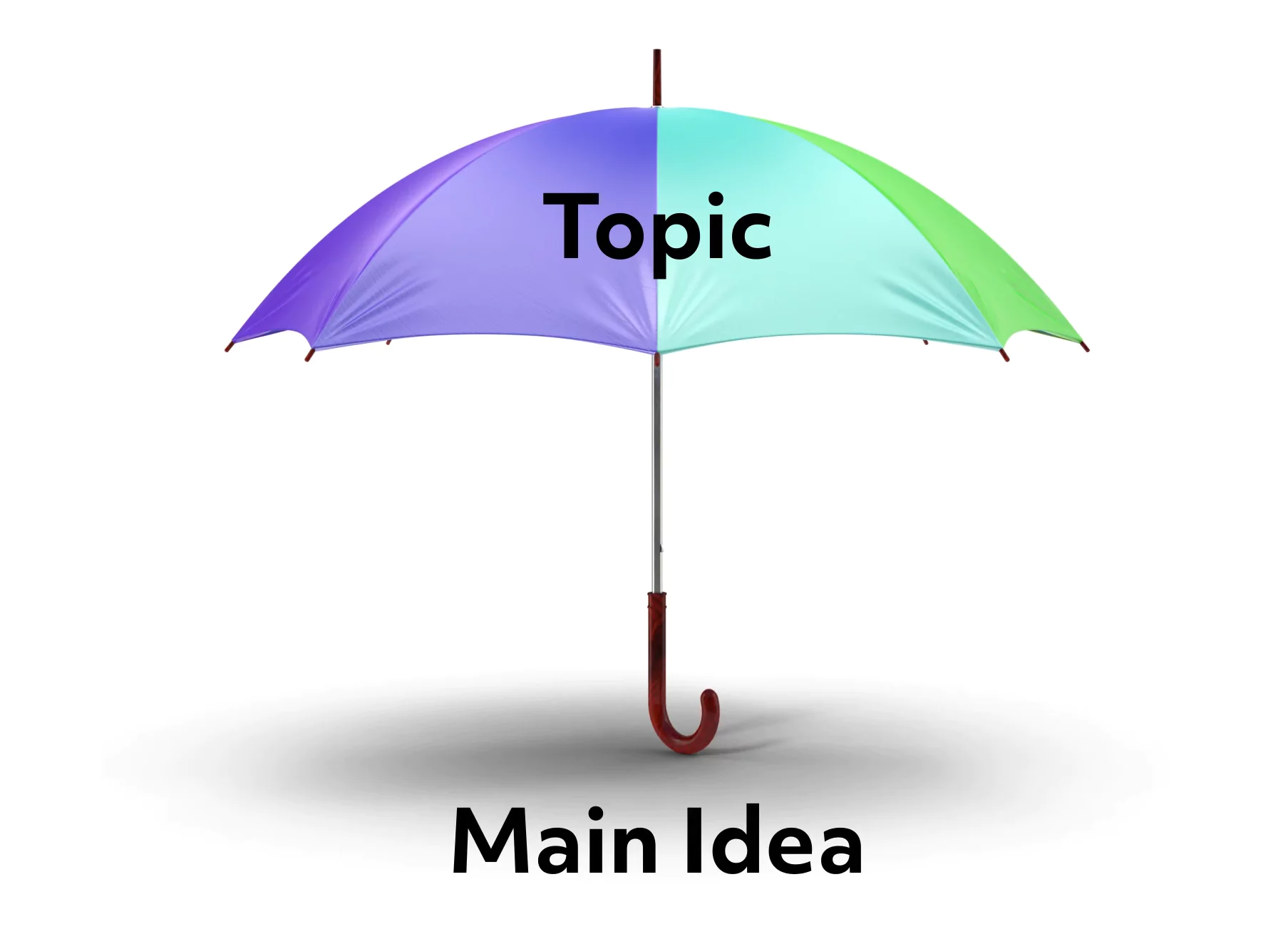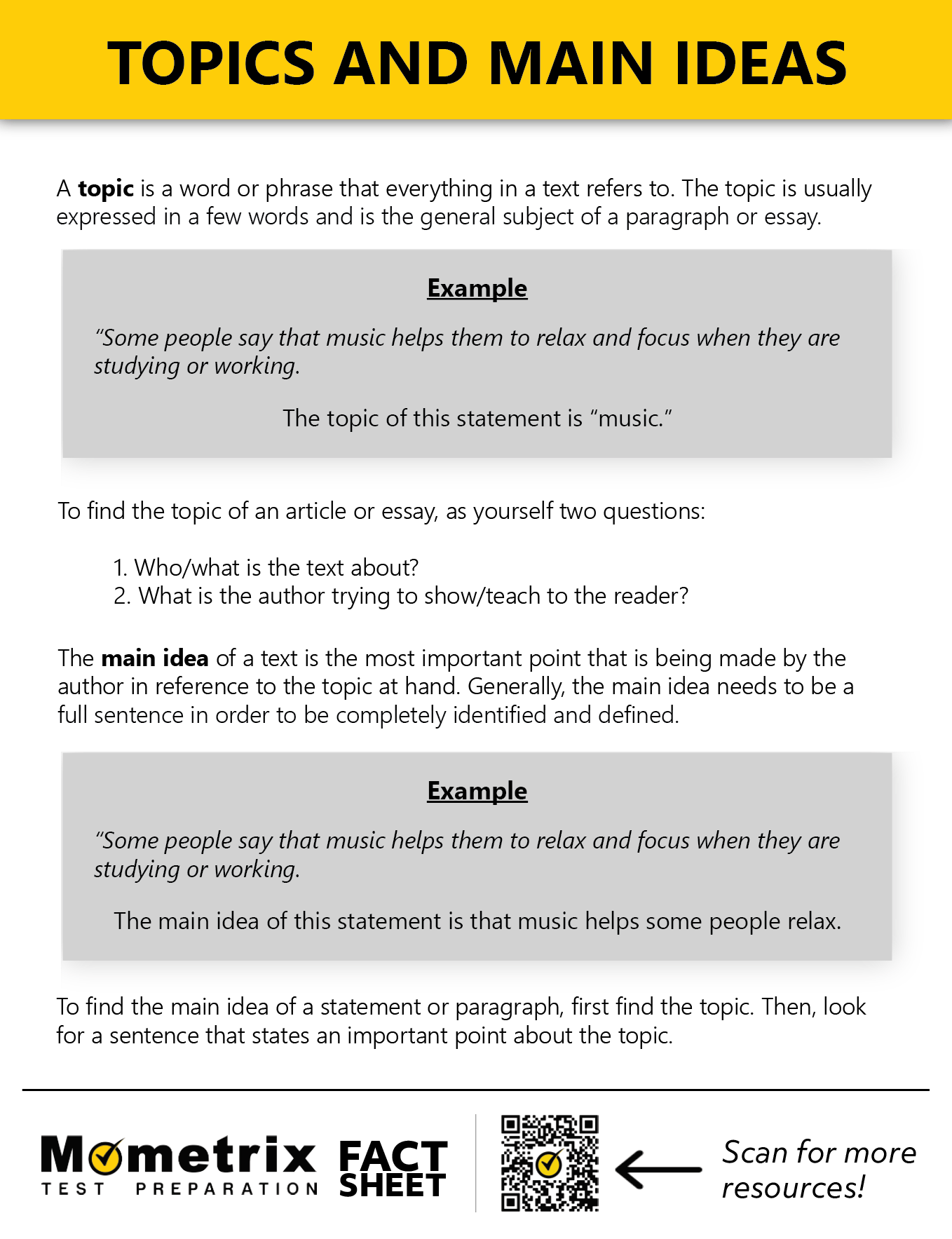
Have you ever tried reading a book or an article and felt lost in a sea of information? Or maybe you’ve struggled to identify the key points and concepts in a class presentation.
One of the most important aspects of becoming an analytical reader is being able to identify the topics and main idea of what you’re reading.
To get started, let’s talk about what a topic is.
Topic vs. Main Idea
The topic of any piece of writing is what it’s about (the subject). The topic can usually be expressed in one word or a short phrase and is more general. The main idea of a piece of writing is the point that the author of the text is trying to make. The main idea can typically be expressed as one sentence and is more specific.
A metaphor that might help you understand the difference is imagining an umbrella. The top of the umbrella represents the topic because it “covers” the entire piece of writing. The handle of the umbrella represents the main idea because it is the thing you’d hold on to when carrying an umbrella, and it supports the topic.

Topic and Main Idea Examples
Example 1
Let’s take a look at a basic example.
If your teacher tells you to write a narrative essay about what you did over the winter break, the topic of the essay will be what you did over the break.
Now, each person’s essay might be a little different, because maybe one student went skiing, maybe one decorated a Christmas tree, maybe one helped make latkes and celebrated Hanukkah. These more specific details will create the main idea of each essay.
Here’s what an essay about skiing might look like:
Okay, one method for identifying the topic is to look for repeated words or phrases, and asking yourself “Who or what is this text about?” In this example, the exact words “winter break” only appear once, but there are other words that refer to “winter break,” like “the week,” and “break from school.” So, using this strategy, if we ask ourselves what this essay is generally about, it’s pretty clear that it’s about winter break.
Now that we’ve identified the topic, let’s determine the main idea. Ask yourself “What is the author trying to show or teach me?” Remember, we’re looking for what the author is trying to tell us, and something that’s more specific than the topic. For this example, we might express the main idea as a sentence like “Skiing was the best part of winter break.”
Example 2
Alright, we’ve had a bit of practice. Now let’s look at a more challenging example adapted from The Wonderful Wizard of Oz by L. Frank Baum.
When Aunt Em came to live there she was a young, pretty wife. The sun and wind had changed her, too. They had taken the sparkle from her eyes and left them a sober gray; they had taken the red from her cheeks and lips, and they were gray also. She was thin and gaunt, and never smiled now. When Dorothy first came to live with her, Aunt Em had been so startled by the child’s laughter that she would scream and press her hand upon her heart whenever the little girl’s merry voice reached her ears; and she still looked at the little girl with wonder that she could find anything to laugh at.
Alright, let’s identify the topic. Who or what is our excerpt about? What words or phrases are repeated? Is there a person or thing that continues to appear in the text?
Using these questions as a guide, we can determine that the topic of the excerpt is Dorothy’s Aunt Em.
Now, let’s think about what the main idea is here. We know the topic is Aunt Em. What is the author trying to show us about Aunt Em? Remember, the main idea is specific and usually requires a full sentence to express.
Let’s list out some of the things we’ve learned about Aunt Em in this passage. She:
- Lives in Kansas
- Is married
- Used to be young and pretty
- Has gray eyes that used to sparkle
- Has gray cheeks and lips that used to be red
- Has a thin, gaunt face
- Never smiles
- Was startled/pained by young Dorothy’s laughter
- Is surprised that Dorothy can find anything to laugh at
Looking at our list, we can see a pretty sad portrait being painted of Aunt Em. A lot of our bullet points focus on the change that has happened in Aunt Em. Let’s try to combine all this into a sentence that expresses the main idea of the passage. Take a minute to jot down a sentence of your own.
Here’s what I came up with: “Aunt Em used to be a bright young woman, but living in the Kansas prairie has turned her into a sad reflection of the person she once was.”
Now, our sentences don’t have to be exactly the same, because we’re different people, and our perspective is different. However, our sentences each need to be rooted in the facts of the passage. Here are a couple of example sentences that would NOT be correct expressions of the main idea, because they’re not factually correct in the passage:
“Aunt Em loves Dorothy as if she were her very own daughter.”
“Aunt Em has lived a hard life, but tries to stay happy because she knows there’s a lot of good in the world.”
Another way to make a mistake when identifying the main idea is to misidentify the topic, and then write a main idea sentence about that incorrect topic. Let’s imagine for a moment that we mistakenly identified the topic as Dorothy when we asked ourselves who this excerpt was about. If we had made that error, we might have written a main idea sentence like:
“Dorothy lives in Kansas and used to laugh a lot when she was young.”
The problem here is that, while those are facts from the passage, a list of random facts does not really answer the question “What is the author trying to show or tell us?” The main idea usually goes a bit beyond the basic facts of the passage, so it requires more analytical thinking than just simple recall of facts.
Review
Okay, we’ve talked about a lot today, so let’s go over a basic review.
Being able to tell the difference between the topic and the main idea of a text will help you become a more analytical reader. The topic of a text is what the piece of writing is about. The main idea of a text is what the author is trying to tell or show the reader about the topic. Asking yourself “Who or what is this text about” can help you identify the topic. Asking yourself “What is the author trying to teach or show me about who or what this text is about” can help you identify the main idea.
I hope this helps you the next time you’re reading. That’s all for now, so thanks for watching, and happy studying!

